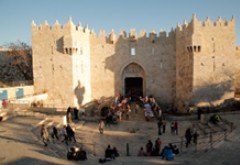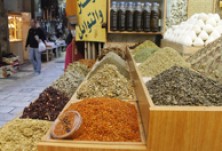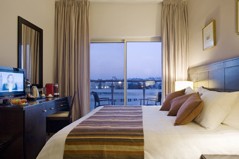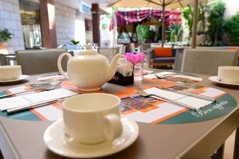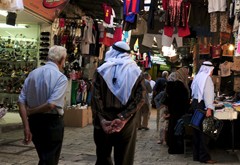The first station of this trail is the Palestinian Museum building, located at the end of the Sultan Suleiman al-Qanuni Street (No. 27), east of al-Madrasa al-Rashidiyya (al-Rashidiyya School), across the northeast corner of the Jerusalem Wall, where Burj (Tower) al-Laqlaq) is located. The Museum is open Sunday through Thursday, from 10 am to 3 pm. It is also open on Saturdays from 10 am to 2 pm (telephone number 02-6708074).
The museum building is one of Jerusalem’s outstanding features. Its six-sided stone tower is a main landmark of Jerusalem’s skyline, especially since the museum was built on a hill. The land on which it was built was known as Shaikh Muhammad al-Khalili’s Orchard, and the remains of the owner’s two-storey mansion can still be seen. The mansion’s style is a true depiction of local traditional Ottoman architecture, which prevailed in Jerusalem and Palestine from the beginnings of the first half of the 17th century and continued until modern construction influences and currents took hold.
Founder and Objectives
The museum is known as the Palestine Archaeological Museum, and in western literature as the Rockefeller Museum, after John Rockefeller, the American magnate who donated $2 million in the late 1920’s to build the museum. The museum was established to house archaeological artifacts discovered in Palestine.
The Museum Holdings
Although the museum holdings are not a direct interest of this book, the author encourages visitors to spend some time to admire its collection of artifacts and to see the inside of the structure, because a full picture of the building can only be appreciated by examining both its inside and outside. In addition, the museum holdings are rich and important and used to include the famous Dead Sea Scrolls discovered in Qumran, which were later removed, after the 1967 occupation of East Jerusalem, to the Israeli Museum. The Dead Sea Scrolls are considered among the most important discoveries of the 20th century. The museum also exhibits a large number of wooden panels from al-Aqsa Mosque, on a temporary loan basis. These panels used to cover the ceiling of al-Aqsa Mosque. In addition, the museum exhibits engraved stone threshold pieces from the entrance of the Church of the Holy Sepulcher, as well as important artifacts discovered in Majiddo, Askalan (Ashkelon), Jerusalem, Lakhish, and other locations.
Designer
The museum building was designed by British engineer Austen St. Barbe Harrison (1891–1976) who studied Islamic and Byzantine architecture. He greatly admired Islamic architecture and was appointed Senior Architect at the Public Works Department of the British Mandate Government. Harrison lived in Jerusalem in an Arab house in al-Thuri neighborhood.
Harrison’s style in designing the museum building, as in most of his buildings, including the British High Commissioner’s palace (now the headquarters of the United Nations), was to merge western architectural styles with the spirit of the east and local traditional architecture. This is evident in the museum building, where he borrowed from the west the general plan prevailing in European public buildings, composed of a number of architectural units. The museum halls were designed like church halls, with high windows that utilize natural light. He was also influenced by buildings in the Old City of Jerusalem, as can be seen from the different levels of the building units. From Andalusian Islamic architecture, he adopted the museum’s internal pool and fountain. Local Jerusalem influences were clear in Harrison’s design, especially where using building stone, as well as its masonry and the group of arches and domes. Armenian ceramic tiles had a special place in his design and decorative elements, signed by the artist David Ohanissian (1884-1952). The museum building is, in fact, an architectural museum in itself, exhibiting the trends passing through Jerusalem as well as depicting the influence of local architecture.
A Lump in the Throat
To a Palestinian, the museum evokes conflicting memories. It is a place where his heritage and great civilization are exhibited, but at the same time, it promotes sad and painful memories. Clashes took place in the museum in 1967 and the Israeli authorities added it to the Israeli Archaeological Authority immediately afterwards, considering it a property of the Jordanian government. The presentation of some of the museum’s content as part of the Israeli museum exhibits in the United States stirred opposition from some of the largest and most famous museums in America.

